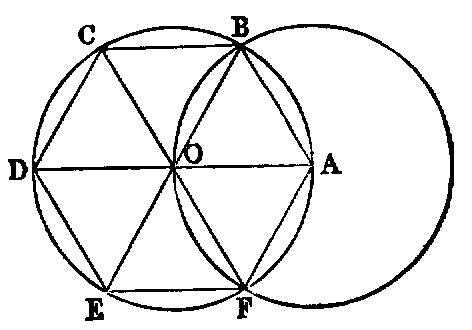Proposition 4.15

In a given circle to inscribe an equilateral and equiangular hexagon.
Let ABCDEF be the given circle; thus it is required to inscribe an equilateral and equiangular hexagon in the circle ABCDEF.
Let the diameter AD of the circle ABCDEF be drawn; let the centre G of the circle be taken, and with centre D and distance DG let the circle EGCH be described; let EG, CG be joined and carried through to the points B, F, and let AB, BC, CD, DE, EF, FA be joined.
I say that the hexagon ABCDEF is equilateral and equiangular.
For, since the point G is the centre of the circle ABCDEF, GE is equal to GD.
Again, since the point D is the centre of the circle GCH, DE is equal to DG.
But GE was proved equal to GD; therefore GE is also equal to ED; therefore the triangle EGD is equilateral; and therefore its three angles EGD, GDE, DEG are equal to one another, inasmuch as, in isosceles triangles, the angles at the base are equal to one another. [I. 5]
And the three angles of the triangle are equal to two right angles; [I. 32] therefore the angle EGD is one-third of two right angles.
Similarly, the angle DGC can also be proved to be onethird of two right angles.
And, since the straight line CG standing on EB makes the adjacent angles EGC, CGB equal to two right angles, therefore the remaining angle CGB is also one-third of two right angles.
Therefore the angles EGD, DGC, CGB are equal to one another; so that the angles vertical to them, the angles BGA, AGF, FGE are equal. [I. 15]
Therefore the six angles EGD, DGC, CGB, BGA, AGF, FGE are equal to one another.
But equal angles stand on equal circumferences; [III. 26] therefore the six circumferences AB, BC, CD, DE, EF, FA are equal to one another.
And equal circumferences are subtended by equal straight lines; [III. 29] therefore the six straight lines are equal to one another; therefore the hexagon ABCDEF is equilateral.
I say next that it is also equiangular.
For, since the circumference FA is equal to the circumference ED, let the circumference ABCD be added to each; therefore the whole FABCD is equal to the whole EDCBA;
Similarly it can be proved that the remaining angles of the hexagon ABCDEF are also severally equal to each of the angles AFE, FED; therefore the hexagon ABCDEF is equiangular.
But it was also proved equilateral; and it has been inscribed in the circle ABCDEF.
Therefore in the given circle an equilateral and equiangular hexagon has been inscribed. Q. E. F.
PORISM.
From this it is manifest that the side of the hexagon is equal to the radius of the circle.
And, in like manner as in the case of the pentagon, if through the points of divsion on the circle we draw tangents to the circle, there will be circumscribed about the circle an equilateral and equiangular hexagon in conformity with what was explained in the case of the pentagon.
And further by means similar to those explained in the case of the pentagon we can both inscribe a circle in a given hexagon and circumscribe one about it. Q. E. F.
